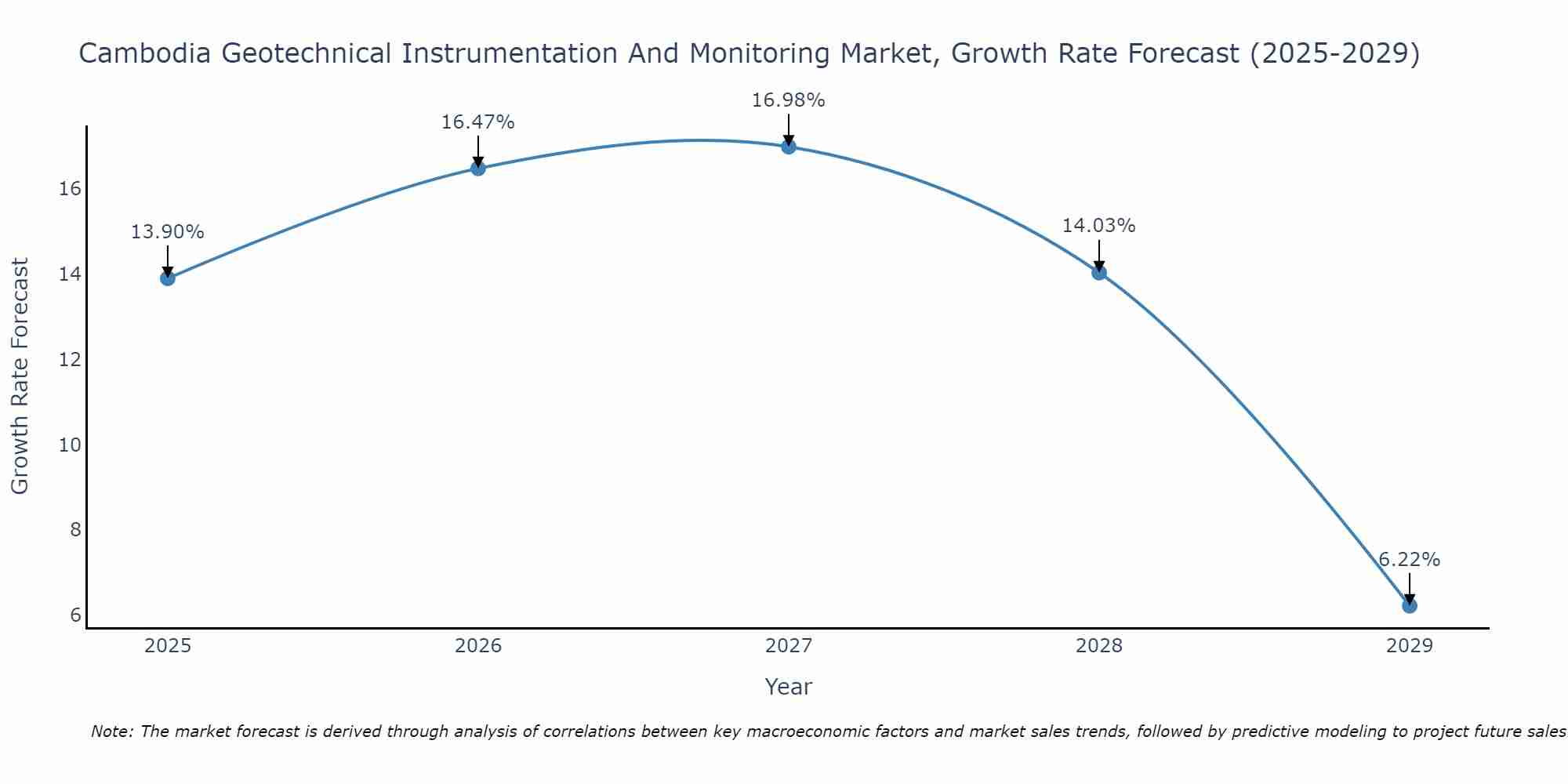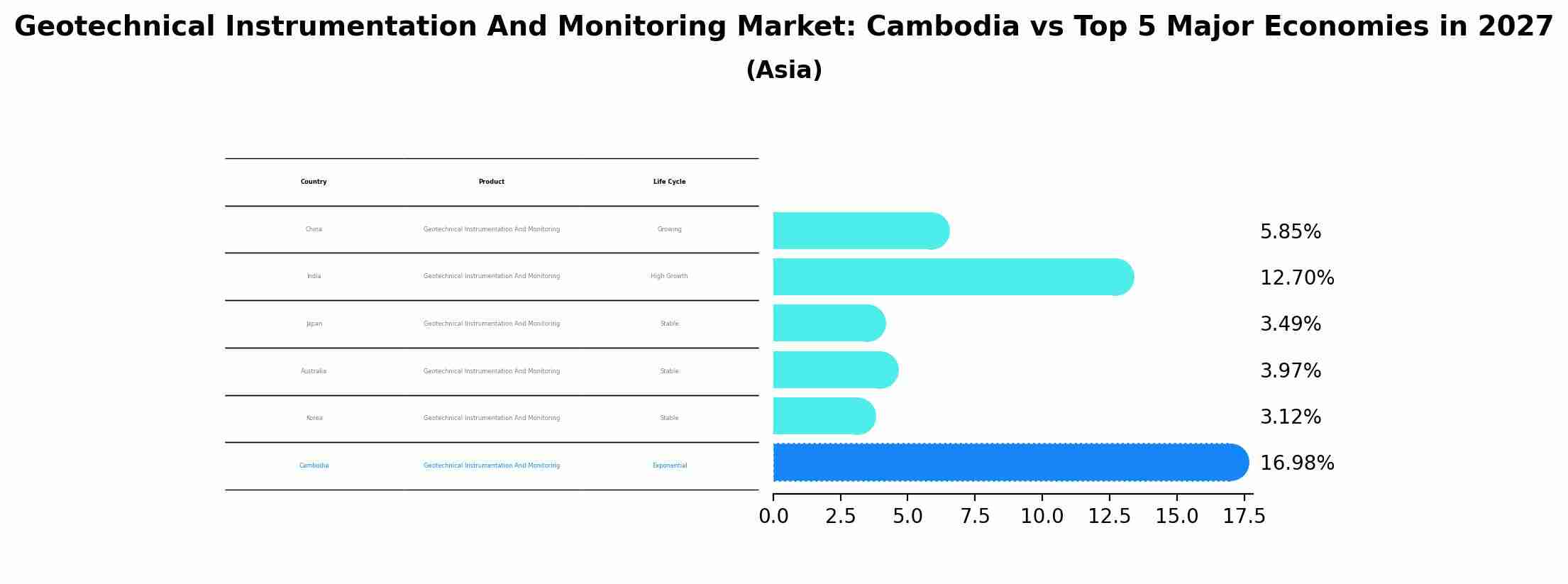Cambodia Geotechnical Instrumentation And Monitoring Market (2025-2031) Outlook | Industry, Analysis, Share, Revenue, Forecast, Growth, Companies, Value, Trends & Size
| Product Code: ETC364533 | Publication Date: Aug 2022 | Updated Date: Aug 2025 | Product Type: Market Research Report | |
| Publisher: 6Wresearch | Author: Summon Dutta | No. of Pages: 75 | No. of Figures: 35 | No. of Tables: 20 |
Cambodia Geotechnical Instrumentation And Monitoring Market Size Growth Rate
The Cambodia Geotechnical Instrumentation And Monitoring Market is projected to witness mixed growth rate patterns during 2025 to 2029. Growth accelerates to 16.98% in 2027, following an initial rate of 13.90%, before easing to 6.22% at the end of the period.

Geotechnical Instrumentation And Monitoring Market: Cambodia vs Top 5 Major Economies in 2027 (Asia)
By 2027, Cambodia's Geotechnical Instrumentation And Monitoring market is forecasted to achieve a exponential growth rate of 16.98%, with China leading the Asia region, followed by India, Japan, Australia and South Korea.

Cambodia Geotechnical Instrumentation And Monitoring Market Synopsis
The Cambodia Geotechnical Instrumentation and Monitoring market is experiencing steady growth driven by increasing infrastructure development projects in the country. Geotechnical instrumentation plays a crucial role in monitoring and assessing the stability of structures, soil conditions, and environmental impacts. Key factors driving market growth include the expansion of transportation networks, urbanization, and the growing awareness of the importance of geotechnical monitoring for safety and sustainability. Major players in the market offer a range of solutions including inclinometers, piezometers, extensometers, and data acquisition systems. The market is characterized by a competitive landscape with both local and international companies vying for market share. With ongoing infrastructure projects and a focus on improving construction quality, the Cambodia Geotechnical Instrumentation and Monitoring market is expected to continue its upward trajectory in the coming years.
Cambodia Geotechnical Instrumentation And Monitoring Market Trends
The Cambodia Geotechnical Instrumentation and Monitoring market is experiencing a notable trend towards the adoption of advanced technologies such as wireless monitoring systems and real-time data analysis software. These technologies offer improved efficiency, accuracy, and cost-effectiveness in monitoring various geotechnical parameters such as slope stability, groundwater levels, and structural health. Additionally, there is a growing emphasis on integrating Internet of Things (IoT) capabilities into geotechnical instrumentation to enable remote monitoring and data transmission. The market is also witnessing an increasing demand for sustainable and environmentally friendly monitoring solutions to support infrastructure development projects in Cambodia. Overall, the trend towards technological innovation and sustainability is driving growth and shaping the future of the Geotechnical Instrumentation and Monitoring market in Cambodia.
Cambodia Geotechnical Instrumentation And Monitoring Market Challenges
In the Cambodia Geotechnical Instrumentation and Monitoring market, some challenges faced include limited awareness and understanding of the importance of geotechnical instrumentation among stakeholders, leading to a reluctance to invest in monitoring solutions. Additionally, the lack of standardized regulations and guidelines for geotechnical monitoring practices poses a challenge in ensuring consistency and quality across projects. Limited access to advanced technology and skilled professionals in the field also hinders the market`s growth potential. Furthermore, the relatively small size of the market and competition from larger international players can make it difficult for local companies to establish themselves and compete effectively. Overall, addressing these challenges will be crucial in unlocking the full potential of the Cambodia Geotechnical Instrumentation and Monitoring market.
Cambodia Geotechnical Instrumentation And Monitoring Market Investment Opportunities
The Cambodia geotechnical instrumentation and monitoring market presents promising investment opportunities due to the country`s growing infrastructure development projects, particularly in construction, transportation, and mining sectors. With the increasing demand for accurate data on ground conditions and structural integrity, there is a rising need for geotechnical instrumentation and monitoring solutions to ensure the safety and stability of these projects. Investors can explore opportunities in providing advanced monitoring equipment such as inclinometers, piezometers, settlement gauges, and vibration sensors, as well as offering data analysis and reporting services. Collaborating with local construction companies, government agencies, and engineering firms can also help investors establish a strong presence in the market and capitalize on the growing demand for geotechnical monitoring solutions in Cambodia.
Jordan Agar Market Government Policies
The Cambodian government has implemented various policies to regulate the Geotechnical Instrumentation and Monitoring market. These policies focus on ensuring the safety and stability of infrastructure projects through the monitoring of ground conditions, foundation stability, and environmental impacts. The government has established guidelines for the installation and maintenance of geotechnical monitoring instruments to assess risks and prevent potential hazards. Additionally, there are regulations in place to standardize data collection and reporting procedures to enhance transparency and accountability in the industry. Compliance with these policies is crucial for companies operating in the Cambodia Geotechnical Instrumentation and Monitoring market to promote sustainable development and maintain the integrity of construction projects in the region.
Cambodia Geotechnical Instrumentation And Monitoring Market Future Outlook
The Cambodia Geotechnical Instrumentation and Monitoring market is expected to witness steady growth in the coming years due to increasing infrastructure development projects and a growing awareness of the importance of geotechnical monitoring in construction activities. Technological advancements in the field of geotechnical instrumentation are likely to drive market growth, with an emphasis on real-time monitoring solutions and data analysis capabilities. Government initiatives to improve construction standards and regulations will also play a key role in shaping the market landscape. Overall, the market outlook for Geotechnical Instrumentation and Monitoring in Cambodia is positive, with opportunities for companies offering innovative solutions to meet the evolving needs of the construction industry in the country.
Key Highlights of the Report:
- Cambodia Geotechnical Instrumentation And Monitoring Market Outlook
- Market Size of Cambodia Geotechnical Instrumentation And Monitoring Market, 2024
- Forecast of Cambodia Geotechnical Instrumentation And Monitoring Market, 2031
- Historical Data and Forecast of Cambodia Geotechnical Instrumentation And Monitoring Revenues & Volume for the Period 2021 - 2031
- Cambodia Geotechnical Instrumentation And Monitoring Market Trend Evolution
- Cambodia Geotechnical Instrumentation And Monitoring Market Drivers and Challenges
- Cambodia Geotechnical Instrumentation And Monitoring Price Trends
- Cambodia Geotechnical Instrumentation And Monitoring Porter's Five Forces
- Cambodia Geotechnical Instrumentation And Monitoring Industry Life Cycle
- Historical Data and Forecast of Cambodia Geotechnical Instrumentation And Monitoring Market Revenues & Volume By Offerings for the Period 2021 - 2031
- Historical Data and Forecast of Cambodia Geotechnical Instrumentation And Monitoring Market Revenues & Volume By Hardware for the Period 2021 - 2031
- Historical Data and Forecast of Cambodia Geotechnical Instrumentation And Monitoring Market Revenues & Volume By Software for the Period 2021 - 2031
- Historical Data and Forecast of Cambodia Geotechnical Instrumentation And Monitoring Market Revenues & Volume By Structure for the Period 2021 - 2031
- Historical Data and Forecast of Cambodia Geotechnical Instrumentation And Monitoring Market Revenues & Volume By Tunnels & Bridges for the Period 2021 - 2031
- Historical Data and Forecast of Cambodia Geotechnical Instrumentation And Monitoring Market Revenues & Volume By Buildings & Utilities for the Period 2021 - 2031
- Historical Data and Forecast of Cambodia Geotechnical Instrumentation And Monitoring Market Revenues & Volume By Dams for the Period 2021 - 2031
- Historical Data and Forecast of Cambodia Geotechnical Instrumentation And Monitoring Market Revenues & Volume By Pipelines for the Period 2021 - 2031
- Historical Data and Forecast of Cambodia Geotechnical Instrumentation And Monitoring Market Revenues & Volume By Others for the Period 2021 - 2031
- Historical Data and Forecast of Cambodia Geotechnical Instrumentation And Monitoring Market Revenues & Volume By End Use for the Period 2021 - 2031
- Historical Data and Forecast of Cambodia Geotechnical Instrumentation And Monitoring Market Revenues & Volume By Buildings & Infrastructure for the Period 2021 - 2031
- Historical Data and Forecast of Cambodia Geotechnical Instrumentation And Monitoring Market Revenues & Volume By Energy & Power for the Period 2021 - 2031
- Historical Data and Forecast of Cambodia Geotechnical Instrumentation And Monitoring Market Revenues & Volume By Oil & Gas for the Period 2021 - 2031
- Historical Data and Forecast of Cambodia Geotechnical Instrumentation And Monitoring Market Revenues & Volume By Mining for the Period 2021 - 2031
- Historical Data and Forecast of Cambodia Geotechnical Instrumentation And Monitoring Market Revenues & Volume By Others for the Period 2021 - 2031
- Cambodia Geotechnical Instrumentation And Monitoring Import Export Trade Statistics
- Market Opportunity Assessment By Offerings
- Market Opportunity Assessment By Structure
- Market Opportunity Assessment By End Use
- Cambodia Geotechnical Instrumentation And Monitoring Top Companies Market Share
- Cambodia Geotechnical Instrumentation And Monitoring Competitive Benchmarking By Technical and Operational Parameters
- Cambodia Geotechnical Instrumentation And Monitoring Company Profiles
- Cambodia Geotechnical Instrumentation And Monitoring Key Strategic Recommendations
Frequently Asked Questions About the Market Study (FAQs):
- Single User License$ 1,995
- Department License$ 2,400
- Site License$ 3,120
- Global License$ 3,795
Search
Thought Leadership and Analyst Meet
Our Clients
Related Reports
- Australia Briquette Market (2025-2031) | Growth, Size, Revenue, Forecast, Analysis, Trends, Value, Share, Industry & Companies
- Vietnam System Integrator Market (2025-2031) | Size, Companies, Analysis, Industry, Value, Forecast, Growth, Trends, Revenue & Share
- ASEAN and Thailand Brain Health Supplements Market (2025-2031) | Strategy, Consumer Insights, Analysis, Investment Trends, Opportunities, Growth, Size, Share, Industry, Revenue, Segments, Value, Segmentation, Supply, Forecast, Restraints, Outlook, Competition, Drivers, Trends, Demand, Pricing Analysis, Competitive, Strategic Insights, Companies, Challenges
- ASEAN Bearings Market (2025-2031) | Strategy, Consumer Insights, Analysis, Investment Trends, Opportunities, Growth, Size, Share, Industry, Revenue, Segments, Value, Segmentation, Supply, Forecast, Restraints, Outlook, Competition, Drivers, Trends, Demand, Pricing Analysis, Competitive, Strategic Insights, Companies, Challenges
- Europe Flooring Market (2025-2031) | Outlook, Share, Industry, Trends, Forecast, Companies, Revenue, Size, Analysis, Growth & Value
- Saudi Arabia Manlift Market (2025-2031) | Outlook, Size, Growth, Trends, Companies, Industry, Revenue, Value, Share, Forecast & Analysis
- Uganda Excavator, Crane, and Wheel Loaders Market (2025-2031) | Strategy, Consumer Insights, Analysis, Investment Trends, Opportunities, Growth, Size, Share, Industry, Revenue, Segments, Value, Segmentation, Supply, Forecast, Restraints, Outlook, Competition, Drivers, Trends, Demand, Pricing Analysis, Competitive, Strategic Insights, Companies, Challenges
- Rwanda Excavator, Crane, and Wheel Loaders Market (2025-2031) | Strategy, Consumer Insights, Analysis, Investment Trends, Opportunities, Growth, Size, Share, Industry, Revenue, Segments, Value, Segmentation, Supply, Forecast, Restraints, Outlook, Competition, Drivers, Trends, Demand, Pricing Analysis, Competitive, Strategic Insights, Companies, Challenges
- Kenya Excavator, Crane, and Wheel Loaders Market (2025-2031) | Strategy, Consumer Insights, Analysis, Investment Trends, Opportunities, Growth, Size, Share, Industry, Revenue, Segments, Value, Segmentation, Supply, Forecast, Restraints, Outlook, Competition, Drivers, Trends, Demand, Pricing Analysis, Competitive, Strategic Insights, Companies, Challenges
- Angola Excavator, Crane, and Wheel Loaders Market (2025-2031) | Strategy, Consumer Insights, Analysis, Investment Trends, Opportunities, Growth, Size, Share, Industry, Revenue, Segments, Value, Segmentation, Supply, Forecast, Restraints, Outlook, Competition, Drivers, Trends, Demand, Pricing Analysis, Competitive, Strategic Insights, Companies, Challenges
Industry Events and Analyst Meet
Whitepaper
- Middle East & Africa Commercial Security Market Click here to view more.
- Middle East & Africa Fire Safety Systems & Equipment Market Click here to view more.
- GCC Drone Market Click here to view more.
- Middle East Lighting Fixture Market Click here to view more.
- GCC Physical & Perimeter Security Market Click here to view more.
6WResearch In News
- Doha a strategic location for EV manufacturing hub: IPA Qatar
- Demand for luxury TVs surging in the GCC, says Samsung
- Empowering Growth: The Thriving Journey of Bangladesh’s Cable Industry
- Demand for luxury TVs surging in the GCC, says Samsung
- Video call with a traditional healer? Once unthinkable, it’s now common in South Africa
- Intelligent Buildings To Smooth GCC’s Path To Net Zero


















